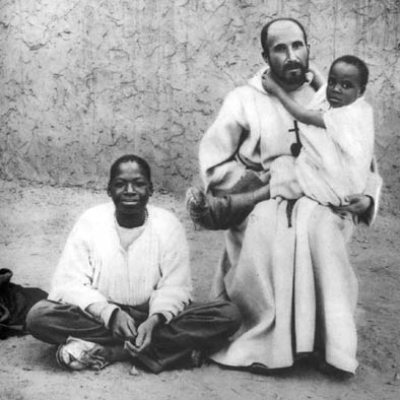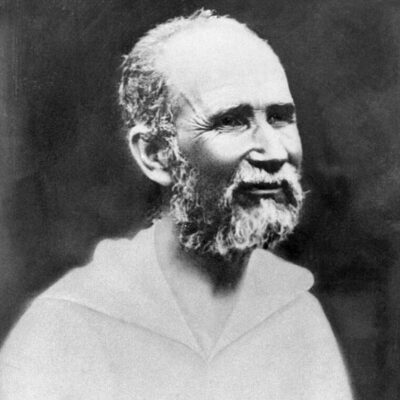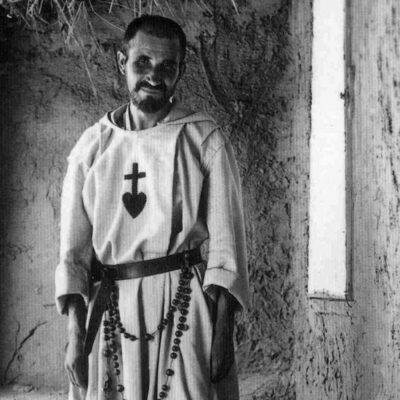Birth, Childhood and Youth
St. Charles de Foucauld was born on September 15, 1858, in Strasbourg, France, into a very Christian family. He was baptized two days after his birth and, on April 28, 1872, received his first communion and confirmation. He lost both parents at just 6 years old. Charles and his sister Maria were placed in the care of his maternal grandfather. At age 12, after the annexation of Alsace by Germany, the family went to live in Nancy.
His Higher Studies, Military Career and Departure from the Faith
Highly intelligent and endowed with a curious spirit, he cultivated a passion for reading at a very early age. He allowed himself to be overcome by the religious skepticism and positivism that marked his era. Soon, in his own words, he lost his faith and immersed himself in a worldly life of gaiety and disorder that nevertheless left him dissatisfied.
In 1876, Charles entered Saint-Cyr for two years. An officer at age 20, he was sent to Algeria. Three years later, not finding what he is looking for, he resigned to undertake, at the risk of his own life, a journey of exploration in Morocco. At that time, it was closed to Europeans; scientific exploration, which he described in the book Reconnaissance au Maroc, 1883-1884.This gained him the glory reserved for 19th-century explorers.
Conversion
The discovery of the Muslim faith, the inner search for truth, the kindness and discreet friendship of his cousin, and the help of Abbé Huvelin led him to rediscover the Christian faith. At the end of October 1886 he went to see Abbé Huvelin at St. Augustine’s Church in Paris: he made his Confession and received Holy Communion. This conversion, no doubt latent for some time, became total and final.
Completely renewed by this conversion, nourished by the Eucharist and Sacred Scripture, Charles de Foucauld understood then that “he could not do otherwise than to live for God” to whom he wanted to consecrate his whole life and thus “exalt himself in pure loss of self before God.” For three years, aided by Abbé Huvelin, he would try to understand how to concretely realize his vocation of total consecration to God. He, who had known wealth and a comfortable life and had been possessed by a great will to power, wanted to imitate Jesus-the Poor One who took “the last place.”
The Search for Holiness, in the Mystery of Nazareth
After a pilgrimage to the Holy Land (1888-1889), where, “walking in the streets of Nazareth on which the feet of Jesus, the poor artisan, rested,” he discovered the mystery of Nazareth, which would henceforth be the heart of his spirituality. He entered the Trappist monastery of Our Lady of the Snows, in the diocese of Viviers in France and, after a few months, was sent to Syria, to the Trappist monastery of Our Lady of the Sacred Heart, a poor Trappist monastery, near Akbès.
He would stay there for 7 years allowing himself to be formed in the monastic school and seeking the most perfect imitation of the living Jesus in Nazareth. But not finding there the radicality he desired, even though “everyone revered him as a saint,” he asked to leave the Trappa. In January 1897, Father Abbot General released him from his temporary Trappist commitments and left him free to follow his personal vocation.
Charles left for the Holy Land and went to live in Nazareth as a servant of the Poor Clares (1897-1900). In service, in very humble work, in meditating on the Gospel at the foot of the Tabernacle he tried to live “the humble and obscure existence of the divine worker of Nazareth,” as a little brother of Jesus in the holy house of Nazareth between Mary and Joseph. Meditating on the mystery of the Visitation, he, who had received “the vocation to the hidden and silent life and not that of a man of words,” discovered that he too can participate in the work of salvation by imitating “the Blessed Virgin in the mystery of the Visitation by silently bringing Jesus and the practice of the evangelical virtues like her […] among unbelieving peoples, in order to sanctify these unfortunate children of God through the presence of the holy Eucharist and the example of the Christian virtues.”
Priestly Ordination and Stay in Algeria
After spending a year of preparation in the monastery of Our Lady of the Snows that had welcomed him at the beginning of his consecrated life, he received priestly ordination on June 9, 1901, in Viviers. Charles was comforted by the certainty that “nothing glorifies God so much down here as the presence and offering of the Eucharist,”,
“My diaconate and priesthood retreats showed me that this life of Nazareth, which seemed to me to be my vocation, had to be lived not in the Holy Land, so beloved, but among the souls the sickest, the sheep and most abandoned.”
So in 1901 Charles de Foucauld headed for the Moroccan frontier, Algeria, and put himself at the service of the Apostolic Prefect of the Sahara, Bishop Guérin, living in the oasis of Beni-Abbès (1901-1904). There he sought to bring Christ to all the men he met “not by words, but by the presence of the Blessed Sacrament, the offering of the divine sacrifice, prayer, penance, the practice of the evangelical virtues, charity, a fraternal and universal charity, sharing the last morsel of bread with every poor man, every guest, every stranger who presents himself, and receiving every man as a beloved brother.”
He built a hermitage, and gave himself detailed regulations, like a monk. But his desire to welcome everyone who knocks at his door soon turns the hermitage into a beehive from morning to night. He wrote: “I want to accustom all the inhabitants, Christians, Muslims, Jews, to look upon me as their brother, the universal brother. They are beginning to call the house ‘the fraternity,’ and I like that very much.”
Missionary of a God-Lover in Tamanrasset, among the Tuaregs
As a result of closed borders with Morocco, he received an invitation to the Hoggar. No priests were allowed to reside there because of the French government’s anticlerical policy. He became oriented toward the Tuareg. Therefore, in 1905, Charles went to live amongst the poorest of poor in the heart of the Sahara, in Tamanrasset. Out of fidelity to his vocation of imitating the hidden life of Jesus in Nazareth, who had made himself small to give a human face to God, Charles made himself small among the poor to reveal the face of a God who is Love: “To love one another, as Jesus loved us, is to make the salvation of all souls the work of our life, giving, in case of need, our blood for him, as Jesus did.”
Love drove him to the point of giving his life on Dec. 1, 1916, he was murdered by raiders in extreme spoliation.
Imitating Poor Jesus to the Point of Death
In death he fulfilled his vocation perfectly,” Silently, secretly like Jesus in Nazareth, obscurely, like Him, passing unknown over the earth like a traveler in the night […] poorly, laboriously, unarmed and dumb before injustice like Him, letting myself like the divine Lamb sheared and immolated without resistance or speech, imitating in everything Jesus in Nazareth and Jesus on the Cross.”
Thus one of the most tenacious desires was fulfilled: the desire to imitate Jesus in His painful and violent death, to give Him the sign of the greatest love and thus complete the union, the merging of the one who loves into the One who is loved.



